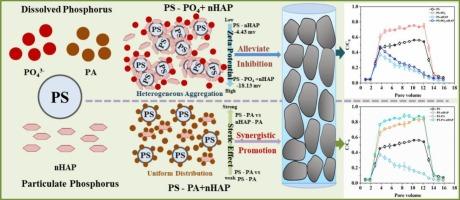溶解磷和颗粒磷在控制聚苯乙烯纳米塑料在多孔介质中的命运中的关键作用
IF 13.2
1区 工程技术
Q1 ENGINEERING, CHEMICAL
引用次数: 0
摘要
不同形态的磷(溶解磷(无机磷(正磷酸盐,PO4)和有机磷(植酸,PA))和颗粒磷(纳米羟基磷灰石,nHAP))影响了纳米塑料的运输和命运。本研究考察了不同形态P的单独和联合作用下聚苯乙烯纳米塑料(PS)在多孔介质中的迁移情况。结果表明,在不同形态P的作用下,PS的迁移速率为:PS-PA + nHAP祝辞PS-PA 祝辞 PS-PO4 祝辞 PS 祝辞 PS-PO4 + nHAP祝辞PS-nHAP,这表明警察丁缓解运输的nHAP PS的抑制效果,而共存的PA和nHAP产生显著的协同对PS的交通便利的影响。各种表征技术的结果,古典或延长Derjaguinee-Landauee-Verweyee-Overbeek (DLVO / EDLVO)理论,密度泛函理论(DFT)计算结果表明,PO4的吸附增加了PS和nHAP的非均相聚集体的负电负性,通过增强静电斥力减轻了nHAP对PS转运的抑制作用。PA分别吸附在nHAP和PS表面,增加了PS与介质之间的静电相互作用和位阻效应,协同促进了PS的转运。其中,PA吸附后PS与nHAP之间的位阻效应是协同促进PS转运的主要因素。该研究为富磷环境中纳米塑料迁移预测模型的建立和风险管理策略的制定提供了理论支持。本文章由计算机程序翻译,如有差异,请以英文原文为准。

Critical role of dissolved and particulate phosphorus in controlling the fate of polystyrene nanoplastics in porous media
The different forms of phosphorus (P) (dissolved P (inorganic P (orthophosphate, PO4) and organic P (phytic acid, PA)) and particulate P (nanohydroxyapatite, nHAP)) influenced the transport and fate of nanoplastics. This study investigates the fate of polystyrene nanoplastics (PS) in porous media under the individual and combined effects of different forms of P. It was shown that under the effect of different P forms, the migration rate of PS was: PS-PA + nHAP > PS-PA > PS-PO4 > PS > PS-PO4 + nHAP > PS-nHAP, which indicated that PO4 alleviated the inhibitory effect of nHAP on the transport of PS, while coexistence of PA and nHAP produced significant synergistic facilitation effect on the transport of PS. The results of various characterization techniques, classical or extended Derjaguinee-Landauee-Verweyee-Overbeek (DLVO/EDLVO) theory, and density function theory (DFT) calculations revealed that the adsorption of PO4 increased the negative electronegativity of the heterogeneous aggregates of PS and nHAP, alleviating the inhibitory effect of nHAP on the transport of PS by enhancing electrostatic repulsion. And PA was adsorbed on the surfaces of nHAP and PS, respectively, increasing the electrostatic interaction and steric effect between PS and the media, which synergistically promoted the transport of PS. Among them, the steric effect between PS and nHAP after adsorption of PA was the main factor for synergistic promoted PS transport. This study provides theoretical support for the development of predictive models for nanoplastic transport in phosphorus-rich environments and risk management strategies.
求助全文
通过发布文献求助,成功后即可免费获取论文全文。
去求助
来源期刊

Chemical Engineering Journal
工程技术-工程:化工
CiteScore
21.70
自引率
9.30%
发文量
6781
审稿时长
2.4 months
期刊介绍:
The Chemical Engineering Journal is an international research journal that invites contributions of original and novel fundamental research. It aims to provide an international platform for presenting original fundamental research, interpretative reviews, and discussions on new developments in chemical engineering. The journal welcomes papers that describe novel theory and its practical application, as well as those that demonstrate the transfer of techniques from other disciplines. It also welcomes reports on carefully conducted experimental work that is soundly interpreted. The main focus of the journal is on original and rigorous research results that have broad significance. The Catalysis section within the Chemical Engineering Journal focuses specifically on Experimental and Theoretical studies in the fields of heterogeneous catalysis, molecular catalysis, and biocatalysis. These studies have industrial impact on various sectors such as chemicals, energy, materials, foods, healthcare, and environmental protection.
 求助内容:
求助内容: 应助结果提醒方式:
应助结果提醒方式:


